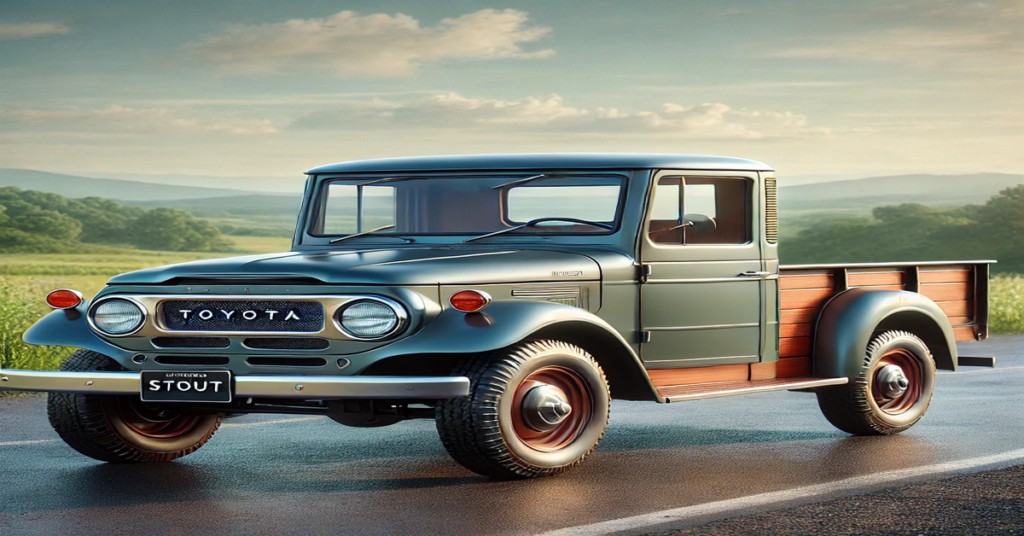The Toyota Stout stands as a significant milestone in the history of pickup trucks, symbolizing durability, reliability, and utility. Introduced in the mid-20th century, the Stout played a pivotal role in establishing Toyota’s reputation in the global automotive market. While Toyota is now renowned for models like the Hilux and Tacoma, the Stout set the foundation for these modern workhorses. This article provides a detailed exploration of the Toyota Stout’s history, design evolution, technical specifications, market impact, and its legacy.
1. Origins and Historical Context
1.1. The Birth of the Toyota Stout
Toyota introduced the Stout in 1954 to cater to the growing demand for versatile and durable light trucks. During post-war Japan’s economic recovery, there was an increasing need for reliable vehicles that could serve both commercial and personal transportation purposes. The Stout was designed to meet this demand, offering a practical solution for businesses and individuals alike.
1.2. Early Market Reception
Upon its release, the Toyota Stout was well-received in Japan due to its robust build and reliability. Its success in the domestic market prompted Toyota to expand its reach internationally, particularly targeting markets in Asia, Africa, and Latin America, where rugged utility vehicles were in high demand.
2. Generations and Design Evolution
2.1. First Generation (1954-1960)
The first-generation Toyota Stout, designated as the RK series, featured a simplistic yet functional design. Powered by a 1.5-liter inline-four engine, it was capable of handling light to moderate loads. This generation emphasized practicality over aesthetics, making it a favorite among small business owners.
2.2. Second Generation (1960-1978)
The second-generation Stout saw significant improvements in both design and performance. With a more modern exterior and enhanced comfort features, it became suitable for a broader range of users. The introduction of a 1.9-liter engine provided better power and fuel efficiency, catering to the needs of global markets.
Key Features:
- Improved suspension for a smoother ride
- Enhanced cabin comfort
- Increased payload capacity
- Availability of both two-wheel and four-wheel-drive options
2.3. Third Generation (1979-1989)
While the Stout’s prominence began to wane with the introduction of the Toyota Hilux, the third generation continued to serve niche markets. This iteration featured a more refined design, better safety features, and improved fuel efficiency, aligning with the global shift towards more environmentally conscious vehicles.
3. Technical Specifications and Performance
3.1. Engine Options
Over its production span, the Toyota Stout was offered with various engine options to cater to different market needs:
- 1.5L R-series Inline-4: Early models focused on basic utility.
- 1.9L 3R-series Inline-4: Improved power output for heavier loads.
- 2.0L 5R-series Inline-4: Offered in later models for enhanced performance.
3.2. Transmission and Drivetrain
Most Stout models came with a 4-speed manual transmission, providing drivers with control over various terrains. The availability of rear-wheel drive (RWD) and four-wheel drive (4WD) options ensured versatility, making the Stout suitable for both urban and off-road applications.
3.3. Payload and Towing Capacity
One of the Stout’s standout features was its impressive payload capacity, which ranged from 1,000 kg to 1,500 kg depending on the model and configuration. This capability made it a preferred choice for industries requiring heavy-duty transportation.
4. Market Impact and Global Reach
4.1. Expansion into International Markets
Toyota strategically positioned the Stout in markets where rugged utility vehicles were essential. Countries in Africa, Southeast Asia, and Latin America became key consumers. In these regions, the Stout was praised for its reliability, ease of maintenance, and adaptability to harsh conditions.
4.2. Competition and Market Challenges
Despite its strengths, the Stout faced competition from other manufacturers like Nissan (with the Datsun series) and Ford. However, Toyota’s reputation for quality and after-sales service often gave the Stout a competitive edge.
4.3. Transition to the Hilux
The introduction of the Toyota Hilux in 1968 gradually overshadowed the Stout. The Hilux offered more modern features, a broader range of configurations, and better global appeal. By the late 1980s, the Stout was phased out, marking the end of an era but leaving a lasting legacy.
5. Restoration and Collectibility
5.1. Growing Interest Among Enthusiasts
In recent years, the Toyota Stout has gained popularity among vintage car enthusiasts and collectors. Its rugged design and historical significance make it a sought-after classic.
5.2. Restoration Projects
Restoring a Toyota Stout involves sourcing original parts, which can be challenging due to the model’s age. However, specialized automotive communities and online marketplaces have made it easier for enthusiasts to find necessary components.
Key Restoration Focus Areas:
- Engine rebuilding and tuning
- Chassis and suspension restoration
- Upholstery and interior refurbishment
- Bodywork and paint restoration
5.3. Market Value and Investment Potential
A well-restored Toyota Stout can fetch impressive prices at classic car auctions. Depending on the model year, condition, and authenticity, prices can range from $10,000 to $30,000 or more.
6. Cultural Significance and Legacy
6.1. Role in Pop Culture and Media
While not as prominently featured in films or television as other vehicles, the Stout has appeared in documentaries and vintage car showcases. Its utilitarian design often symbolizes hard work and reliability.
6.2. Influence on Modern Toyota Pickups
The Stout’s influence is evident in Toyota’s modern pickup lineup. Features like durability, versatility, and user-friendliness, first introduced with the Stout, continue to define models like the Hilux and Tacoma.
6.3. Preservation Efforts
Automotive museums and Toyota heritage programs have taken steps to preserve the legacy of the Stout. Exhibitions showcasing restored models highlight the vehicle’s historical importance and engineering advancements.
7. Comparative Analysis: Toyota Stout vs. Toyota Hilux
7.1. Design Philosophy
- Toyota Stout: Focused on basic utility and ruggedness.
- Toyota Hilux: Offers a balance of utility, comfort, and modern features.
7.2. Performance and Versatility
While the Stout laid the groundwork, the Hilux expanded upon it with advanced engines, better safety features, and more configuration options.
7.3. Market Reach and Longevity
The Stout enjoyed success in specific markets, whereas the Hilux became a global phenomenon, continuing production to this day.
8. Maintenance Tips for Toyota Stout Owners
8.1. Regular Engine Check-Ups
Given the age of most Stout models, routine engine maintenance is crucial. Replacing old gaskets, belts, and filters can prevent costly repairs.
8.2. Suspension and Brake Maintenance
The Stout’s suspension system requires periodic checks, especially for vehicles frequently used on rugged terrains. Upgrading to modern brake systems can enhance safety without compromising authenticity.
8.3. Bodywork and Rust Prevention
Rust is a common issue for vintage vehicles. Regular inspections and applying anti-rust coatings can significantly prolong the vehicle’s lifespan.
9. Conclusion
The Toyota Stout remains a remarkable chapter in Toyota’s history. Its role in establishing Toyota’s global footprint, combined with its durability and practical design, has cemented its place in automotive heritage. While production ceased decades ago, the Stout’s legacy lives on through restoration efforts, collector interest, and its influence on modern pickup designs.
For enthusiasts and collectors, owning a Toyota Stout is not just about possessing a vehicle; it’s about celebrating a piece of automotive history that symbolizes resilience, innovation, and timeless appeal.
FAQs
1. When was the Toyota Stout first introduced?
The Toyota Stout was first introduced in 1954 as Toyota’s answer to the growing demand for light-duty pickup trucks.
2. Why did Toyota stop producing the Stout?
Toyota discontinued the Stout in the late 1980s to focus on the more modern and versatile Toyota Hilux, which offered improved features and global appeal.
3. What engine options were available for the Toyota Stout?
The Stout was equipped with various engines over its production span, including 1.5L, 1.9L, and 2.0L inline-four engines.
4. Is the Toyota Stout a good investment for classic car collectors?
Yes, due to its historical significance and increasing rarity, a well-maintained or restored Toyota Stout can be a valuable addition to any classic car collection.
5. How much does it cost to restore a Toyota Stout?
Restoration costs vary depending on the vehicle’s condition but typically range from $5,000 to $20,000, depending on the extent of work required.
6. Where can I find parts for restoring a Toyota Stout?
Parts can be sourced from online marketplaces, vintage car clubs, specialized restoration shops, and Toyota heritage programs.







